Art /Entertainment
The Impact of Technology in the Film Industry
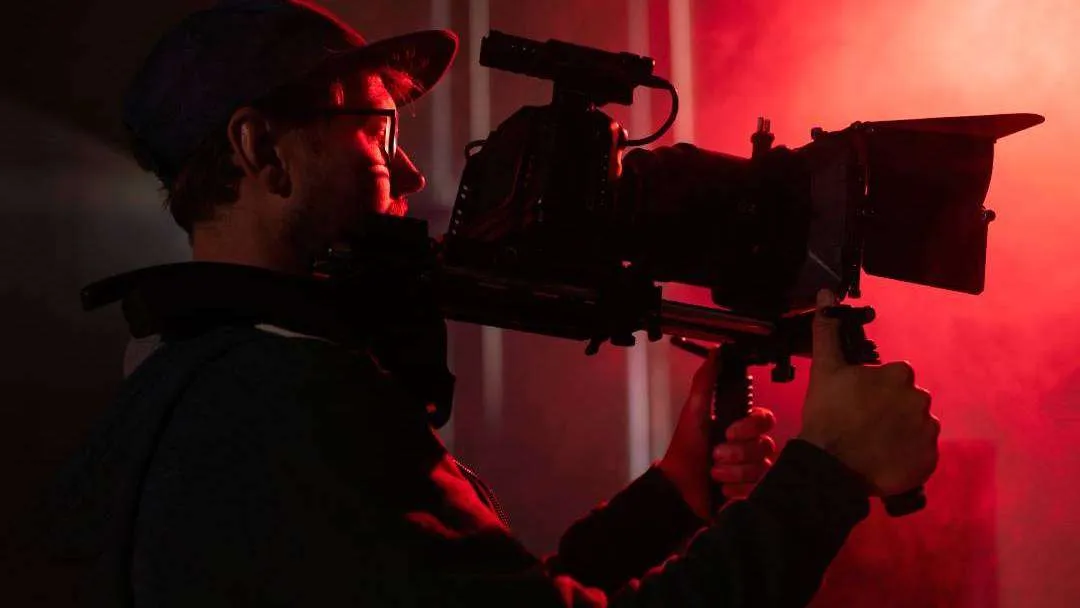
Introduction
The film industry has changed a lot over the years, with technology playing a huge role in shaping its future. From the first films to today’s digital filmmaking and streaming services, technology has transformed how movies are made, shown, and watched. In this article, we’ll look at how Technology Film Industry has impacted filmmaking, special effects, movie distribution, and how audiences enjoy films.
The Move from Film to Digital

Image by: Yandex.com
One of the biggest changes in filmmaking is the switch from traditional film to digital cameras. In the past, movies were filmed on physical film reels, which needed special handling and processing. Today, digital cameras allow filmmakers to capture high-quality footage without the need for expensive film stock and complicated editing.
Benefits of Digital Filmmaking:
- Cheaper: Digital cameras save money by not needing expensive film reels or processing.
- Convenient: Filmmakers can instantly review footage, making adjustments as needed.
- Better Quality: Digital cameras offer clearer images and perform better in low light.
This change has made filmmaking more affordable and creative for filmmakers, allowing them to try new ideas and techniques.
The Rise of Special Effects and CGI
Image by: Yandex.com
Special effects (SFX) have been a part of movies for a long time. But today, CGI (Computer-Generated Imagery) has opened up even more possibilities. With CGI, filmmakers can create realistic effects like explosions, giant monsters, and futuristic cities, which were impossible to make just a few decades ago.
Benefits of CGI and Special Effects:
- More Creative Freedom: Filmmakers can create anything they imagine, no matter how impossible.
- Realistic Effects: CGI looks so real that viewers often can’t tell the difference between CGI and real footage.
- Safety: Dangerous scenes that would put actors at risk can now be made safely using CGI.
Movies like Avatar and The Avengers series show just how powerful CGI has become in creating unforgettable movie moments.
The Benefits of Digital Movie Storage and Archiving
Before digital technology, films were stored on physical reels, which could deteriorate over time. Today, movies are stored digitally, which makes it easier to preserve them for future generations. Digital storage also makes it possible to store huge amounts of films in smaller spaces, reducing the need for physical storage. This digital archiving has made it easier for filmmakers, studios, and museums to access old films and share them with the world, ensuring that great movies are not lost to time.
Digital Projection and Movie Distribution

Image by: Yandex.com
Before digital technology, films had to be distributed as physical reels, which was expensive and took a long time. Today, movies are shown in theaters using digital projectors. This change has made it easier and cheaper to distribute films worldwide.
Advantages of Digital Projection:
- Cheaper: There’s no need for physical film reels anymore.
- Faster Distribution: Movies can be sent digitally to theaters all around the world.
- Better Quality: Digital projectors give a clearer and sharper image than traditional film projectors.
With the rise of streaming platforms like Netflix, Amazon Prime, and Disney+, viewers now have more ways to watch movies. They can enjoy films at home, on their phones, or on their TVs at their convenience.
The Growth of Streaming Services

Image by: Yandex.com
Streaming services have had a huge impact on how movies are distributed and watched. Services like Netflix, Hulu, and Amazon Prime Video allow people to watch movies whenever they want, on various devices like smartphones, tablets, and smart TVs. This has caused a decline in traditional TV and physical rentals, as people prefer streaming.
Benefits of Streaming Services:
- Convenience: You can watch movies anytime, anywhere.
- Wide Selection: Streaming services offer a huge variety of films, including indie films and documentaries.
- Original Content: Many streaming platforms now produce their own movies and TV shows, giving filmmakers new opportunities.
Streaming has also changed how movies make money, with studios now focusing on both theater releases and streaming platforms to reach more viewers.
Changes in Film Editing
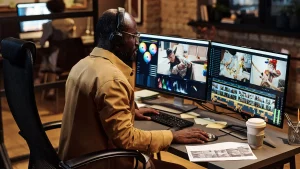
Image by: Yandex.com
Film editing has also been made easier by technology. In the past, editors had to physically cut and tape together film reels. Today, digital editing software allows editors to work faster and more creatively. Programs like Adobe Premiere Pro and Final Cut Pro help editors put together the final version of a movie quickly and efficiently.
Benefits of Digital Editing:
- Faster: Digital editing saves time and allows for quicker changes.
- Precision: Editors can make precise adjustments to colors, sounds, and effects.
- More Options: Digital software provides many tools to enhance the film’s visuals and sound.
Virtual Reality (VR) and Augmented Reality (AR) in Film
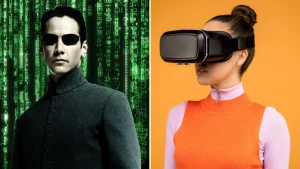
Image by: Yandex.com
Virtual reality (VR) and augmented reality (AR) are newer technologies that are starting to change how we experience films. VR allows viewers to fully immerse themselves in a movie, while AR adds digital elements to the real world, creating a mix of real and virtual experiences.
Benefits of VR and AR in Film:
- Immersive: VR can make viewers feel like they are inside the movie, interacting with the environment.
- Interactive: VR and AR allow for different kinds of storytelling, where the audience can make decisions or experience things from different angles.
- New Entertainment: These technologies could create new ways to tell stories that weren’t possible before.
Movies like The Lion King and Blade Runner 2049 have already started using VR and AR to give audiences new ways to experience films.
The Impact of Digital Cameras on Filmmaking

Image by: Yandex.com
One of the biggest changes in filmmaking is the use of digital cameras. In the past, filmmakers had to use physical film, which was expensive and required special processing. Today, digital cameras are more affordable and easy to use. They allow filmmakers to shoot high-quality footage, review their work right away, and make quick changes if needed. This has made the filmmaking process faster and more flexible, helping filmmakers to create their best work without worrying about costly mistakes.
How Special Effects Have Changed With Technology
Special effects have always been part of movies, but with technology, they’ve become more impressive than ever. Computer-generated imagery (CGI) allows filmmakers to create things that were once impossible, like massive explosions or aliens from other worlds. CGI helps make these effects look realistic, so the audience feels like they’re part of the action. Technology has made special effects more affordable, allowing filmmakers of all budgets to use them in their movies, creating more exciting and engaging films for everyone.
How Technology Helps Film Editing
Technology has made film editing easier and faster. In the past, editors had to physically cut and paste film reels to put the movie together. Today, digital editing software, like Adobe Premiere or Final Cut Pro, allows editors to make changes quickly and with more precision. They can adjust the sound, color, and even add special effects with just a few clicks. This makes the editing process smoother and gives editors more creative control over the final product.
Streaming Services and the Shift in Movie Distribution
With the rise of streaming services, technology has completely changed how people watch movies. Platforms like Netflix, Hulu, and Amazon Prime Video allow people to watch films anytime, anywhere, without going to a theater. This shift has made it easier for viewers to access a wider variety of movies, including films that might not have been shown in theaters. Streaming services also let people watch entire seasons of shows or multiple films in one sitting, making it more convenient than ever to enjoy entertainment at home.
The Role of Virtual Reality in Movie Experiences
Virtual reality (VR) is an exciting new technology that is starting to be used in movies. VR allows viewers to feel like they’re inside the movie, experiencing the story in a more personal way. With VR headsets, people can interact with characters or explore the world of the movie in 360 degrees. This new technology is changing the way people watch films, allowing for a deeper connection to the story. While still in its early stages, VR has the potential to take movie watching to a whole new level.
How Technology Has Made Filming Safer
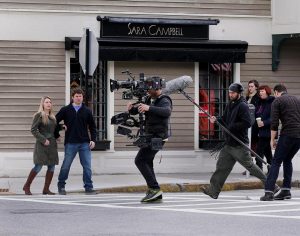
Image by: Yandex.com
With new technology, filming has become much safer. In the past, action scenes often required dangerous stunts and risky situations. Today, filmmakers can use special effects, CGI, and motion capture to create realistic action sequences without putting anyone in harm’s way. For example, a car chase or fight scene can be created using digital tools, keeping the actors safe while still delivering thrilling scenes. Technology helps protect crew members and actors while still keeping the excitement and realism that audiences love.
How Technology Has Changed Movie Soundtracks
Technology Film Industry has also made a huge impact on how movie soundtracks are created. In the past, musicians would record music with live instruments in a studio, which took time and effort. Today, digital tools and software allow composers to create soundtracks using computers, synthesizers, and virtual instruments. This makes it easier to create a variety of sounds and music styles. It also allows filmmakers to experiment with different audio effects, helping to create more unique and emotional soundtracks that match the mood of the movie perfectly.
The Growth of Animation Thanks to Technology
Animation has also greatly benefited from technological advancements. In the past, animators would draw each frame by hand, which was time-consuming and expensive. Today, digital animation software allows artists to create animations more quickly and with more detail. With 3D animation, filmmakers can create realistic-looking characters and environments, which makes animated films look more lifelike. This technology has allowed animation to become a major part of the film industry, with films like Frozen and Toy Story showing how powerful and creative digital animation can be.
The Impact of Social Media on Film Marketing
Social media has changed how films are marketed and how audiences connect with movies. In the past, film marketing mainly involved TV ads, posters, and trailers in theaters. Today, social media platforms like Instagram, Twitter, and TikTok allow filmmakers and studios to promote movies directly to fans. This has created new opportunities for movie promotions, as fans can share their excitement and create buzz around upcoming releases. Social media also helps people discover new films and engage with filmmakers and actors, making movie marketing much more interactive and personal.
The Influence of Mobile Technology on Film Viewing
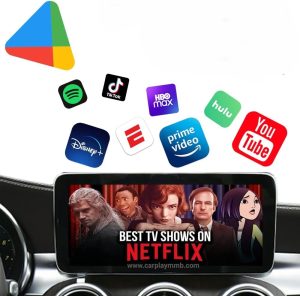
Image by: Yandex.com
Mobile technology has changed the way many people watch movies. With smartphones and tablets, viewers can now watch films on the go, whether they’re commuting, traveling, or just relaxing at home. Streaming apps like Netflix, YouTube, and Disney+ have made it easy for people to enjoy movies and TV shows on their mobile devices. This shift to mobile viewing has allowed for more flexible watching habits and made movies more accessible to a wider audience, no matter where they are.
The Challenges of Technology in the Film Industry
Despite the many benefits, technology in the film industry also comes with challenges. The cost of high-tech equipment and special effects can be expensive. Digital technology also requires ongoing training for filmmakers and crew. Moreover, the rise of streaming platforms has caused traditional movie theaters to struggle as more people prefer to watch movies at home.
The Future of Technology in Film

Image by: Yandex.com
The future of film looks bright, with even more technology likely to change how movies are made. Technologies like artificial intelligence (AI) and blockchain are already being explored to improve filmmaking and distribution.
Future Possibilities:
- AI in Filmmaking: AI could help writers create scripts, assist in casting, and even help edit films.
- Blockchain: Blockchain could improve how films are distributed, making it easier for filmmakers to track rights and payments.
- Better CGI: Future CGI will likely be even more realistic and detailed, allowing filmmakers to create even more stunning visual effects.
Comparative Table: Traditional vs. Modern Film Industry
| Aspect | Traditional Film | Modern Film |
|---|---|---|
| Filmmaking | Shot on film, manual editing | Digital cameras, computer-based editing |
| Special Effects | Practical effects, simple CGI | Advanced CGI, motion capture, visual effects |
| Distribution | Physical film reels, limited access | Digital projection, worldwide distribution |
| Audience Experience | In theaters, on TV | Streaming, on-demand viewing, VR experiences |
| Cost | High cost for film and editing | Lower cost with digital tools and software |
Technology’s Impact: A Simple Analysis
| Technology | Effect on Filmmaking | Effect on Distribution | Effect on Audience Experience |
|---|---|---|---|
| Digital Filmmaking | Cheaper, faster production | Easier and cheaper to send movies worldwide | Better quality, immediate editing |
| CGI and Special Effects | More creative possibilities, realistic effects | Allows for spectacular, lifelike effects | More exciting and visually stunning movies |
| Streaming Services | Easier access to a wide range of films | Movies can be watched from anywhere at any time | Watch movies on demand, anytime, anywhere |
| VR and AR | Interactive storytelling, immersive experiences | New ways to watch films | Fully immersive, hands-on movie experiences |
Conclusion
Technology has completely transformed the film industry. From digital filmmaking and advanced special effects to streaming services and VR, these innovations have changed how films are made, shown, and enjoyed. The future holds even more exciting possibilities, with AI, blockchain, and other technologies paving the way for a new era of filmmaking.
Art /Entertainment
Diablo 4 Experience: Guide to Buying Items, and Unique Gear

Equipment you choose in Diablo 4 will have a direct impact on both the strength and fantasy of your character, with Aspect modifiers offering unique benefits that can enhance it further.
Season 11 brings new seasonal mechanics and significant alterations to gear and the itemization system, along with an entirely new endgame challenge. Be ready for anything by stocking up on powerful Chaos-Infused Legendary items, speed farming picks, and other essential tools!

Buying Items
Diablo 4 players will benefit greatly from having an experienced character equipped with powerful weapons and armor upgrades.
As they explore Sanctuary’s treacherous realms, they encounter sinister foes that require upgraded weaponry or armor upgrades – helping them battle more effectively against foes while progressing further through the game. These upgrades elevate a character’s stats so they can battle more efficiently while progressing further into it.
Earning these powerful d4 items takes considerable effort in the form of battles and quests, but players who prefer an easier path may prefer buy diablo 4 items with Diablo 4 Gold as an effective alternative.
Purchase diablo 4 items for sale from reputable sellers to ensure the highest-quality equipment. It is essential to remember that purchasing fake items can be highly risky; before making your decision it is vitally important that the seller has a valid BattleTag and character name as well as excellent customer service and fast delivery capabilities. Authentic sellers offer top-tier customer support as well as fast deliveries of their merchandise.
Buying Gold
Gold is the in-game currency that can be used to diablo 4 buy items. These may include potions, keys, tomes and scrolls as well as more valuable options like perfect gems (which can be rerolled in the Horadric Cube to create runes) and socketed weapons or armor.
Buy Diablo 4 items is also beneficial because it allows players to bypass tedious grinding sessions and enjoy more of the game’s exciting combats and intriguing lore.
Grinding may be enjoyable, but it can become tiresome quickly. By purchasing items, players can bypass these tedious sessions and enjoy their game more quickly – not to mention gain access to unique gear that will increase chances of victory in PvP battles or quest completion! Gold can also be used as an efficient means of paying NPCs as it takes up no inventory space or affect their character’s movement speed or stamina levels!
Buying Boosts
Diablo’s world is filled with both threats and treasures, yet gathering the best weapons, armor sets, and magic items can be a difficult challenge.
Players can either scour for them themselves through grinding or buy them through its vibrant community; purchasing these resources saves time by letting you immerse yourself more deeply into battle while exploring its rich lore without needing to constantly search for items.
Grinding for items can be an exhausting and time-consuming task that takes away from the excitement of Sanctuary’s gripping combat and vast world. To gather items efficiently, players need to kill group monsters while activating Evil Urns or Monster Shrines to summon champion monsters that have an increased chance of dropping valuable items.
They also must constantly manage their inventory as only so many items can fit within town at one time; purchasing these items from reliable sources allows players to avoid this tedious process altogether and focus on enjoying its incredible action and engaging lore instead.
Buying Unique Items
Finding the ideal weapons and armor sets in Diablo 4 can mean the difference between success and defeat. Finding such gear often requires hours of grinding or epic boss battles; buying items diablo 4 may offer an easier alternative to grinding.
Unique weapons or items are items with their own individual names and artwork, featuring predetermined lists of modifiers as well as potential bonuses. Such weapons and armor may be created or dropped from certain non-boss enemies in certain areas or obtained through special reliquary keys, supporter packs or auction houses.
Some diablo 4 unique items have a flag to indicate they cannot be duplicated, meaning players may only possess one copy in their inventory and bank. This applies to foil uniques as well as those influenced by external influences. Additional uniques may be obtained by mailing them or purchasing it through auction house sales.
Boost Your Rewards
As players progress through Blizzard Entertainment’s dark world of Sanctuary, they face increasingly challenging obstacles that require powerful upgrades. These upgrades come in the form of weapons with improved skill bonuses and armor sets with upgraded attributes, as well as powerful runes and gems that can shift battle tides.
While farming enemies or completing quests may yield these items eventually, it takes much longer. For those wanting a faster solution than this grind method, Diablo2items.net offers reliable online platforms offering D4 items as an efficient alternative solution.
Diablo2items.net Trading Window makes buying and selling items in D4 simple by securely exchanging BattleTag and Character Name with sellers. In addition, you have the option of receiving your items either through friend request or team invite if that suits your preference.
Art /Entertainment
Slope Game: Mastering Speed and Precision for the Challenge

Have you ever felt the need for speed, combined with the precision of a surgeon and the reflexes of a ninja? If so, then you’ve probably stumbled upon the addictively simple, yet fiendishly challenging , Slope game.
It’s a web-based game that has captivated casual gamers and hardcore players alike, with its endless descent, minimalist graphics, and heart-pounding gameplay.
This isn’t a game about complex storylines or intricate strategies; it’s about pure, unadulterated reaction time and spatial awareness. So, buckle up, and let’s explore how to master this exhilarating game.

Gameplay: A Symphony of Speed and Precision
The premise of Slope is deceptively simple: you control a ball, hurtling down an infinitely generated slope dotted with red blocks. Your goal? To survive for as long as possible, accumulating a high score in the process. Sounds easy, right? Wrong.
The ball is controlled solely by the left and right arrow keys (or ‘A’ and ‘D’ for those who prefer that configuration). Pressing these keys abruptly shifts the ball from side to side.
The catch is the speed. The further you descend, the faster you go, and the narrower the gaps between the blocks become. What starts as a leisurely roll soon becomes a frantic dance of reflexes, demanding lightning-fast decisions and impeccable timing.
The game constantly throws new challenges your way. The slope isn’t always straight; it curves, twists, and throws you into precarious angles. You’ll encounter speed boosts that amplify the sense of velocity, and often find yourself relying on split-second judgments to avoid careening into an unforgiving red block.
Adding to the tension, the game’s aesthetics contribute to the experience. The stark, geometric environment, combined with the pulsing electronic soundtrack, creates a mesmerizing and slightly hypnotic atmosphere.
It’s a world stripped down to its bare essentials, forcing you to focus entirely on the immediate challenge. You can locate the game and test your abilities at Slope.
Tips and Tricks: Conquering the Infinite Descent
While Slope is primarily about reflexes, there are a few techniques that can drastically improve your performance and help you climb the leaderboards (or at least beat your own personal best).
- Master the Short Tap: Resist the urge to hold down the arrow keys. Short, controlled taps are far more effective than prolonged presses. This allows for finer adjustments and prevents you from overcorrecting and smashing into a wall. Think of it like gently nudging the ball rather than violently shoving it.
- Anticipate, Don’t React: As your speed increases, reacting to obstacles becomes virtually impossible. Instead, try to anticipate upcoming turns and gaps based on the patterns of the blocks ahead. Look further down the slope to prepare for what’s coming.
This is when spatial awareness becomes relevant
- Embrace the Curves: Don’t fight the curves; embrace them. Use the momentum of the curves to your advantage, guiding the ball along the arc. Resisting the curve will often lead to losing control.
- Listen to the Music: The soundtrack isn’t just for ambiance; it provides subtle cues. Certain changes in the music can indicate upcoming obstacles or changes in the slope’s direction.
- Practice Makes Perfect (Seriously): This might sound cliché, but it’s incredibly true for Slope. The more you play, the better you’ll become at predicting patterns, reacting to changes, and controlling the ball at high speeds.
Don’t lose hope due to initial setbacks; perseverance is essential.
-
Pause Periodically: Slope requires a high level of concentration and quick reactions. Engaging in prolonged play can result in tiredness and annoyance. Take frequent breaks to refresh your mind and avoid exhaustion. A new viewpoint can frequently result in enhanced performance
Why It’s So Addictive
What makes Slope Game so enjoyable is its balance of frustration and reward. You’re never more than a few seconds away from a new run, and every improvement feels like a victory. Its minimal graphics and techno soundtrack create that irresistible “just one more try” feeling.
In an age of overly complex games, Slope stands out as a sleek, fast, arcade-style challenge that’s easy to start and hard to quit.
Conclusion: More Than Just a Game
Slope is more than just a simple web game; it’s a test of skill, a challenge to your reflexes, and a strangely addictive experience. Its minimalist design and straightforward gameplay belie its deep level of challenge and the satisfaction that comes from conquering the infinite descent.
Whether you’re a seasoned gamer looking for a quick burst of adrenaline or a casual player seeking a fun and engaging way to kill time, Slope offers something for everyone.
So, go ahead, give it a try. Just be warned: you might find yourself hooked. Good luck, and may your descent be long and prosperous!
Art /Entertainment
Custom Jewelry at Careems: Crafting Meaningful Expressions

Discovering the Art of Custom Jewelry at Careems
This article explores why custom jewelry is becoming so popular, what makes Careems a leader in the industry, and how choosing personalized pieces can create lasting value across generations.

Why Custom Jewelry Matters More Than Ever
In the past, people often purchased jewelry as part of tradition—weddings, birthdays, cultural celebrations. While this still holds true, modern buyers look for something deeper: individuality.
Custom jewelry allows people to shape their own story through design, craftsmanship, and emotion. Instead of wearing what everyone else has, customers can collaborate with expert jewelers to bring a unique vision to life.
There are several reasons why custom jewelry has become a preferred choice:
1. Personal Expression
Custom pieces reflect personality. Whether it’s a ring designed around a memory, a necklace inspired by a loved one, or earrings crafted to match one’s style, customers can design exactly what they imagine.
2. Emotional Connection
A custom design often carries sentimental meaning. Engagement rings, wedding bands, or anniversary gifts created uniquely for someone make the moment more special and memorable.
3. Higher Craftsmanship Standards
When creating custom jewelry, expert jewelers spend more time perfecting each detail. This often results in better quality than mass-produced items.
4. Long-Term Value
Custom jewelry pieces can become heirlooms. Families pass them down through generations, giving them historical and emotional importance.
In Sri Lanka, where tradition blends beautifully with modern style, these reasons make custom jewelry a growing trend among young buyers, travelers, and couples alike.
Careems: A Heritage Jewelry Store With Timeless Craftsmanship
When discussing premium craftsmanship in Sri Lanka, Careems is a name that consistently stands out. Established generations ago, Careems is more than just another jewelry store it is a symbol of trust and artistry. Many locals and visitors recognize it as one of the country’s most respected jewelers.
Careems built its reputation through:
• Skilled artisans
Their craftsmen have decades of experience in goldsmithing, gem-setting, and design. Sri Lanka’s long history with gemstones, especially sapphires, gives Careems access to expert teams who understand the art deeply.
• High ethical standards
Customers value transparency when buying gold, diamonds, or Sri Lankan sapphires. Careems prioritizes authenticity and responsible sourcing, an essential factor in today’s jewelry market.
• Personal service
Unlike large commercial stores, Careems gives customers a personalized experience. Their consultants guide clients through every step, from choosing stones to approving final CAD designs.
• Elegance through simplicity
Careems is known for designs that are refined, balanced, and timeless rather than overly flashy. This subtle sophistication appeals to customers looking for long-lasting beauty.
These qualities make Careems a preferred destination for anyone seeking custom jewelry that blends tradition with modern elegance
The Custom Jewelry Experience at Careems
Creating custom jewelry can feel overwhelming at first, especially for buyers who don’t know much about gem quality or design. But Careems simplifies the process, making it enjoyable and educational.
Here’s how the experience often unfolds:
1. Initial Consultation
Customers meet with a designer or consultant to share their idea. It could be a sketch, a Pinterest photo, or even a simple description. Careems listens carefully to interpret the vision accurately.
2. Selecting Materials
Next comes choosing gemstones and metals. Careems provides expert guidance on Sri Lankan sapphires, diamonds, gold purity levels, and other materials. Customers learn about quality grades, colors, clarity, and pricing.
3. Design Visualization
Using modern design tools, Careems creates 3D models or sketches so customers can see what the final piece will look like. This stage allows changes, adjustments, and refinements.
4. Crafting the Piece
Once approved, the piece moves into production. Skilled craftsmen work with meticulous care, from shaping the metal to setting the gemstones. Every detail is handcrafted to perfection.
5. Final Delivery
The completed piece is polished, inspected, and presented beautifully. Many customers describe this moment as emotional — especially when it’s for a proposal, wedding, or family celebration.
This clear, supportive process is one reason why Careems remains a top jewelry store for personalized creations.
Why Customers Prefer Careems Over Other Jewelry Stores
There are many jewelry shops in Sri Lanka, but Careems continues to attract customers both locally and internationally. Several factors explain this consistent preference:
❖ Authenticity and Trust
Careems has decades of experience, and its reputation has remained strong throughout the years. Customers trust them with important purchases like engagement rings and wedding jewelry.
❖ Focus on Quality, Not Mass Production
While many stores push ready-made designs, Careems specializes in meaningful custom pieces crafted to last a lifetime.
❖ Heritage Meets Modern Technology
They combine traditional craftsmanship with modern tools like CAD design, creating a blend of precision and artistry.
❖ Strong Customer Relationships
Many families return to Careems for generations, which says a lot about the store’s commitment to service and satisfaction.
❖ International Appeal
Tourists visiting Sri Lanka often choose Careems for high-quality gemstones — especially Ceylon sapphires, which are globally famous.
The Future of Jewelry: Personal, Meaningful, and Custom-Made
As the world becomes more digital, customers still crave human connection and meaningful experiences. Jewelry shopping is no exception. The rise of custom jewelry shows that people want pieces that match their identity, values, and memories.
Careems recognizes this shift and continues to innovate while protecting its rich heritage. Whether it’s a simple pendant or a luxurious engagement ring, the store ensures every custom creation is crafted with passion and precision.
In the years ahead, the demand for personalization will only grow. And as more customers seek authenticity and emotional value, Careems is well positioned to remain one of Sri Lanka’s most trusted jewelry stores.
-
Business2 years ago
Cybersecurity Consulting Company SequelNet Provides Critical IT Support Services to Medical Billing Firm, Medical Optimum
-
Business2 years ago
Team Communication Software Transforms Operations at Finance Innovate
-
Business3 years ago
Project Management Tool Transforms Long Island Business
-
Business2 years ago
How Alleviate Poverty Utilized IPPBX’s All-in-One Solution to Transform Lives in New York City
-
health3 years ago
Breast Cancer: The Imperative Role of Mammograms in Screening and Early Detection
-
Sports3 years ago
Unstoppable Collaboration: D.C.’s Citi Open and Silicon Valley Classic Unite to Propel Women’s Tennis to New Heights
-
Art /Entertainment3 years ago
Embracing Renewal: Sizdabedar Celebrations Unite Iranians in New York’s Eisenhower Park
-
Finance3 years ago
The Benefits of Starting a Side Hustle for Financial Freedom































